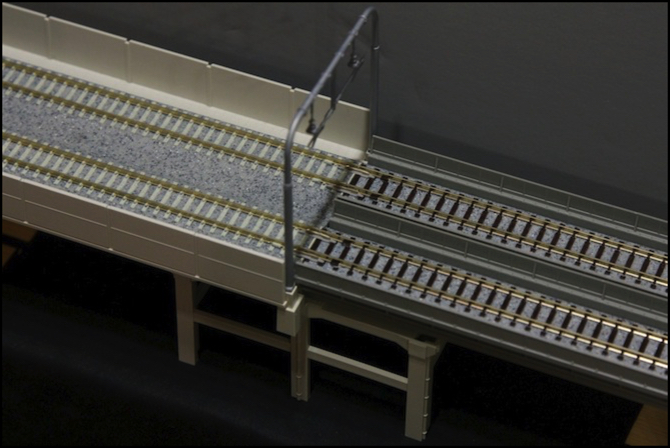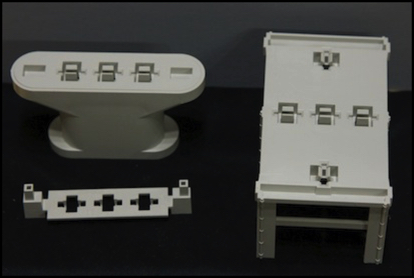Kato Viaduct Track
17 May 2012 01:08 Filed in: Structures

A question on the JNS Forum the other day started me thinking about viaduct track. I’ve used this in the past, although not at present. And at the time, I found it confusing, and the lack of English-language information about it compounded the problem. In attempting to answer the question and refresh my own knowledge I did some research and decided to fill out those notes a bit and add them to the site. There’s a new page for that, linked below, but I’ll provide a quick summary of the interesting bits here.
Kato’s viaduct track is a bit of an oddity. This represents a modern style of construction using pre-stressed concrete segments. It’s appropriate for Shinkansen lines in Japan, both urban and rural, and some urban commuter track as well. But why they sell it in the U.S. at all has always baffled me. Most of our elevated track dates from the 1920’s or earlier, and used iron or steel lattice supports, exposed I-beams, and poured concrete or even stone blocks. It’s a very different look. All that said, the single track viaduct is a good stand-in for modern ballasted-deck bridges (Kato also sells other kinds of bridges). And if you model Japanese (as I do) or European trains, modern viaduct makes much more sense.
Kato isn’t the only provider either, Tomix makes a more extensive line of viaduct compatible with their FineTrack, but I know very little about that and haven’t used it, so I can’t comment further. While FineTrack and Unitrack can be connected using an adapter, that’s not true of their viaducts (since there’s no viaduct-to-viaduct adapter). You’d need to make all elevated track using one kind, stick in a bit of ground-level track with the adapter, or do a bit of kitbashing.
As you can see in the photo above, both the double-track viaduct (left) and the single-track viaduct (right) are compatible. That’s generally true of all Unitrack, although there are some cases where “compatible” means “goes together but not without problems”.
Both kinds of viaduct use ordinary Unitrack attached to a separate plastic element. Double-track is clipped in and can be removed and replaced (it’s really easy to break the clips on the track when removing it though, so caution is required). Single-track is screwed in. All viaduct uses white S-joiners to clip the structural elements to each other and to supports, but the track still goes together with Unijoiners to make electrical contact and align the rails.
Kato makes several styles of support for both single and double track (and the double-track ones can be used for two single-tracks as shown above). And these same supports will work with their bridges (which can connect directly to viaduct, as well as with their elevated Viaduct Station (although the pre-cast style double-track support shown above has advantages as a station support).

Poured-concrete style (left) and Pre-cast Style (right) supports, with catenary support (lower left)
Also, while all single-track viaduct today uses wooden-tie Unitrack, the double-track viaduct is available in two forms. The normal kind replicates a concrete-slab base typical of Shinkansen lines (and used in the U.S. for subway and other high-use lines). However, the V12 set rather surprisingly uses concrete-tie track. This was actually among the first Unitrack I bought, and for the longest time I though all viaduct used concrete ties, although in truth you can’t get the concrete-tie viaduct other than in the V12 set.
My experience of viaduct track is somewhat limited. While my original Kitchen Table Layout uses a viaduct station reached by up-and-down track made from the V12 set, the current layout uses ground-level track. It still has a viaduct station in the urban scene, but this is reached by a bridge at one end, and a raised section of ground-level track at the other. I have several bits of single-track viaduct being used for ballasted-deck bridges though. I’m planning to swap the wood-tie track for concrete-tie track on a couple of those so they’ll fit in better, but haven’t gotten to it yet.
There’s a lot of detail related to viaduct track, and I’ve created a Kato Viaduct Track page to capture my notes on those details. I’ve also realized, thanks in part to an editorial in the British Railway Modeller magazine, that there’s a lot of jargon in this hobby, and perhaps more than usual in viaduct track, so I’ve created a Glossary page in my Model Trains section as well. Creating that made me realize just how nonsensical some of our language must sound to a beginner. Why is the joint in the middle of a switch called a “frog”? The word actually derives from the shape of part of a horse’s hoof, which I never knew before I just looked it up. Very strange.



